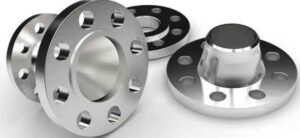ASME Flanges, engineered by the American Society of Mechanical Engineers (ASME), are an integral part of various industries, ensuring the safe and efficient operation of piping systems. This article delves into the crucial aspects of ASME Flanges, exploring their standards, types, applications, and more.
Image source: Texasflange.com
ASME Flanges: Setting the Standards
ASME, founded in 1880, is a multifaceted organization that not only sets engineering standards but also conducts research and development, offers training and education, and serves as a non-profit entity. ASME standards are globally recognized and cover a wide range of disciplines. They aim to establish consistent guidelines and best practices that enhance operational efficiency, safety, and cost-effectiveness for users at all levels.
ASME B16.5: The Core Standard
ASME B16.5 is a fundamental standard for manufacturing cast and forged steel pipe flanges and flanged fittings. It encompasses various aspects, including:
- Pressure-Temperature Ratings: Defining the maximum allowable working pressure of materials at specific temperatures.
- Materials and Dimensions: Specifying the materials, dimensions, tolerances, and marking of flanges and fittings.
- Types of Flanges: Covering a range of flange classes, from 150 to 2500, in different sizes.
- Flange Joints: Addressing the key components of flanged joints, such as flanges, gaskets, and bolting.
Types of ASME Flanges
ASME Certified flanges come in various designs, each tailored to specific industrial needs. The six common designs are:
- Slip-on Flanges: Slide onto pipes for a snug fit.
- Weld Neck Flanges: Machined to fit a pipe’s inside diameter and fastened through welding.
- Blind Flanges: Seal the ends of pipes and vessel openings.
- Lap Joint Flanges: Partner with stub end fittings for easy assembly and disassembly.
- Threaded Flanges: Fit threaded pipes without welding.
- Socket-Weld Flanges: Fit pipes socket-style with a top weld for maximum inner flow.
Image source: Texasflange.com
ASME Flanges in Action
ASME Flanges are crucial in diverse applications and industries, ensuring strength, durability, and high performance. They are commonly found in:
- High-volume valves and vessels.
- Industrial pumps and manufacturing systems.
- Food and beverage processing.
- Large-scale pipe systems and waterworks.
- Heat exchangers and systems.
- Nuclear power plants.
- Oil and gas drilling.
- Petrochemical treatment and processing.
The ASME Difference
ASME Flanges set the standard for reliability and safety in piping systems. With their rigorous guidelines, they offer a level of consistency and predictability that is vital in today’s industrial landscape. Whether you’re a manufacturer, owner, employer, or user, ASME Flanges ensure a robust, secure, and high-performance piping system.
Frequently Asked Questions (FAQs):
What is ASME, and why are ASME Flanges significant?
ASME stands for the American Society of Mechanical Engineers, an organization that sets engineering standards to ensure safety and efficiency in various industries. ASME Flanges are critical components in piping systems that adhere to these standards.
What are ASME B16.5 standards, and how do they relate to flanges?
ASME B16.5 is a key standard that specifies the requirements for manufacturing cast and forged steel pipe flanges and flanged fittings, including pressure-temperature ratings, materials, and dimensions.
How many classes of flanges does ASME B16.5 cover?
ASME B16.5 covers flange classes ranging from 150 to 2500, ensuring compatibility with various pressure and temperature requirements.
What are the common types of ASME Flanges?
ASME Flanges come in various designs, including slip-on, weld neck, blind, lap joint, threaded, and socket weld flanges, each suited for different applications.
What industries benefit from ASME Certified Flanges?
ASME Certified Flanges are crucial in a wide range of industries, including oil and gas, nuclear power, petrochemical processing, and food and beverage manufacturing.
How do ASME Flanges ensure safety in high-pressure systems?
ASME Flanges are designed to withstand high pressures and temperatures, preventing leaks and ensuring the safety of piping systems.
What is the role of ASME Flanges in ensuring operational consistency?
ASME Flanges play a vital role in maintaining operational consistency by setting strict standards and best practices for flange design and usage.
What is the difference between ANSI and ASME Flanges?
ANSI, or the American National Standards Institute, focuses on establishing engineering standards, while ASME focuses on standards for mechanical devices. Both organizations work together to ensure universal engineering standards.
Are ASME Flanges used internationally, and are their measurements the same worldwide?
ASME Flanges are used internationally, and their measurements are nearly identical to those of ANSI standards, except in a few rare instances.
Why are flanged joints essential in ASME Flange systems?
Flanged joints consist of flanges, gaskets, and bolting, playing a crucial role in ensuring leak-tight connections within ASME Flange systems.
What are the considerations for using ASME Flanges at high and low temperatures?
ASME Flanges must account for potential leakage due to external forces and thermal gradients, which vary at high and low temperatures.
Are ASME Flanges subject to hydrostatic testing?
Flanged fittings may undergo system hydrostatic tests, ensuring their integrity in high-pressure environments.
How are ASME Flanges identified and marked for compliance?
ASME Flanges must be marked with the manufacturer’s name, material, pressure ratings, conformance to ASME standards, temperature, size, and ring joint groove number.
What materials are commonly used for ASME Flanges?
ASME Flanges are typically made from materials such as forged carbon steel, alloy steel, stainless steel, and more, depending on the application.
What tolerance standards apply to ASME Flanges, and how do they ensure precision in manufacturing?
Tolerance standards ensure precise measurements, including center-to-contract surfaces, center-to-end, flange facings, and flange bore diameter, all detailed in ASME standards.
Conclusion
ASME Flanges, manufactured under the meticulous guidance of the American Society of Mechanical Engineers (ASME), are vital components in industrial piping systems. ASME B16.5 standards provide the blueprint for their construction, addressing pressure-temperature ratings, materials, and dimensions, with a broad range of class options to suit various demands. These versatile flanges, available in multiple designs, underpin the reliability and safety of industries such as oil and gas, nuclear power, and petrochemical processing. Their adherence to stringent standards ensures operational consistency, making them an indispensable cornerstone of industrial processes worldwide.
For more in-depth information on ASME flanges and their applications, visit: https://www.texasflange.com/flange-specs/ansi-asme/

